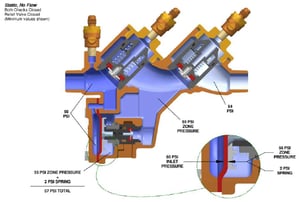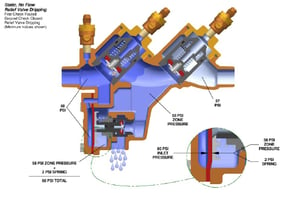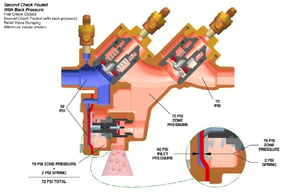An RPZ (or “reduced pressure zone” backflow preventer) is the best backflow prevention device because it uses the system hydraulics to operate the valve, and if anything in the system is not working properly, the RPZ will let you know that repairs are needed. This feature of “failing” in order to alert problems is why RPZ backflow preventers have always been used in “high hazard” applications.
How Does an RPZ Work?
As far as how an RPZ works, Sean Perry, national sales manager at Apollo Valves always says, “RPs are very easy to understand. 60psi of water comes into the valve, hits a 5psi minimum differential spring in the first check, path of least resistance is to go through a sensing line down to the 2psi differential relief valve spring and close the relief valve, now water can go past the first check losing 5psi into the zone and with zone pressure of 55psi plus the 2psi relief spring, 57 psi against 60 psi, 60psi wins that fight every single time, now the water can satisfy the demand downstream by going past the second check with a minimum 1psi differential spring. Super easy and the relief valve is happy.”
Well said, Sean. Obviously, the hydraulics are quite complicated, and we’ll break down a few scenarios, but as Sean said, if you keep the relief valve happy, then your RPZ is working properly.
How Do You Keep an RPZ Working Properly?
To keep it simple, the “Z” in RPZ stands for ZONE of pressure, and that zone of pressure keeps the valve operating properly and lets you know that it’s protecting your water supply. If no water is dripping or dumping out of the relief valve, then you KNOW your relief valve is happy and your RPZ is operating properly.
Here is a quick diagram of what Sean was explaining:

It’s important to remember that the relief valve of an RPZ is designed to be OPEN. Right out of the box, the spring on the relief valve is pushing it open, and not until the valve is installed and the supply pressure goes through the sensing line, does the relief valve actually close. So when an RPZ “fails,” it is really just doing what it was made to do, which is open the relief valve and let you know there is a problem.
Here is a diagram of a very common occurrence. Debris is caught in the first check, which throws off the “balance” of the zone of pressure in the valve. This makes the relief valve NOT happy, it does NOT remain closed, and it lets you know there is a problem by dripping or flowing water.

We always say that if your relief valve is dripping or flowing water, then 9 times out of 10, there is debris in the first check. Always check this first when repairing an RPZ backflow preventer.
Here is another diagram to help you understand what happens when an RPZ fails. This does not happen very often, but sometimes there is debris in the second check, and as you can see, the zone of pressure is compromised, and it makes the relief valve unhappy.

Hopefully, these diagrams and descriptions will help you understand that when an RPZ fails, it means that it’s actually just doing its job of alerting you to a problem. The hydraulics of the system and the differentials in spring tensions of the checks and relief valve all work together to keep the relief valve happy and let you know that your water supply is protected from backflow.
Learn more about the best practices in backflow prevention, to keep your systems operating correctly. Download our free Best Practices guide today.




